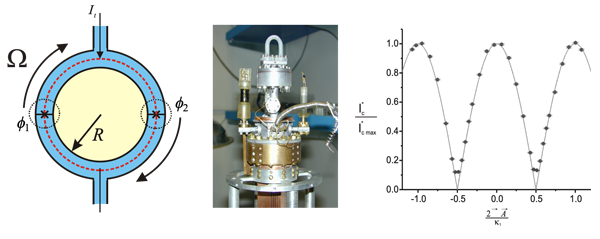Macroscopic Quantum Interferometers
Research Status
Superfluid Josephson junctions use nano-aperture arrays through which the fluid can flow quantum mechanically. We invented such junctions and then discovered superfluid Josephson oscillations (Nature 388, 449 (1997)), the current-phase relationship of a superfluid Josephson junction (Science 278, 1435 (1997)), π-states within the Josephson junction (Nature 392, 687 (1998)). The key technical outcome was development of the first superfluid macroscopic quantum interferometer (DC-SQUID; Nature 412, 55 (2001)). This device is completely insensitive to electromagnetism but couples directly to inertial accelerations and rotations.

Fig. 7A Schematic of a superfluid macroscopic quantum interferometer, here sensing rotation W. B) Image of a functional superfluid macroscopic quantum interferometer with sensing area ~3cm2, C) Measured interference patterns of superfluid macroscopic quantum interferometer (DC SQUID) with changing rotation.
Research Plans
Because the inertial mass of an 4He atom is ~109 that of an optical photon, quantum interference of atom wavefunctions is concomitantly (extraordinarily) more sensitive to inertial effects.
a) Development of large-scale (meter) version of a superfluid interferometer (Nature 412, 55 (2001)) as a prototype for modular atomic interferometry
b) Development of large-scale quadrupolar sensitivity superfluid 4He interferometer in an ultra-low vibration environment, for low frequency studies of metric stain dynamics.
